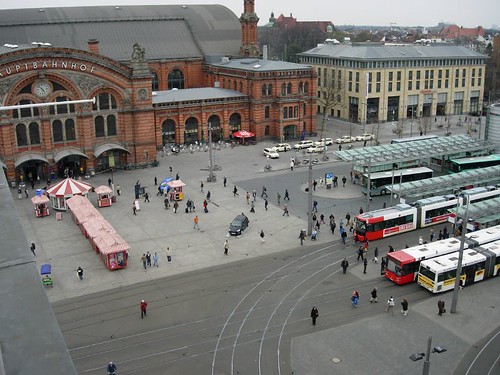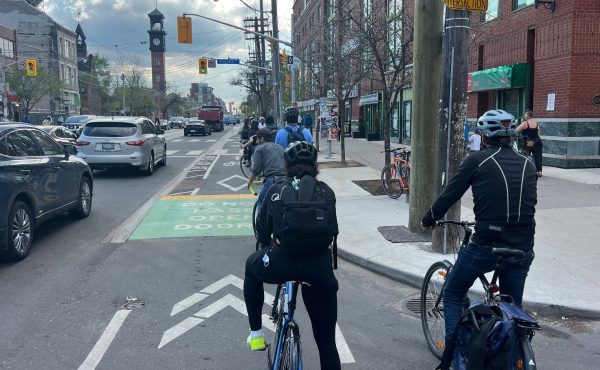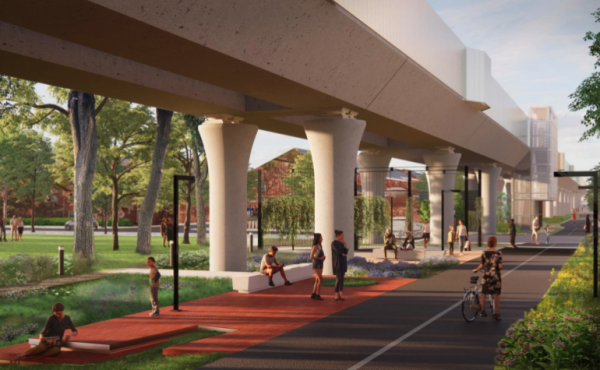
Last week, I posted some of the interesting material I heard about Kingston, Ontario, at Moving the Economy‘s workshop on sustainable transportation.
In this week’s NOW magazine, I wrote about the inspiring transportation work being done in Bremen, Germany, which was presented at the same workshop.
The presentation was given by Michael Glotz-Richter, Senior Project Manager of Sustainable Mobility for the city (don’t you wish we had someone with that title in Toronto?), who provided way more information and examples than I could squeeze into the article. He was also very entertaining — Bremen has produced two cheesy-fun short videos in which a “James Bond” character outwits and outruns his enemies by using Bremen’s sustainable transportation services while they try to get around in a car, stuck in traffic. Another part of his presentation compared using private automobiles to having a shopping cart in your house — in your corridors (streets), living room (parks vs. parking), children’s playroom (schools). It just takes up so much room.
This entertaining approach has a serious point behind it. Glotz-Richter noted how important the emotional aspects of decision-making are. We can argue all we want, but people do not make decisions based on purely rational reasons. So, if you want to get people to change their behaviours, you need to understand and appeal to people’s emotional motivators, their instincts. It’s not just about moving people, but about moving them comfortably and happily. He gave the example of cycling becoming popular because it is seen as healthy and therefore sexy, and about the appeal of the prestige of a fancy bike. He noted that one of the reasons cycling remained more popular in Bremen than in some other German cities is that it was never seen as a “poor person’s” form of transportation, as it was in some places after the Second World War, so it didn’t get discarded when people returned to prosperity. It was a really interesting point, because we definitely tend to emphasize the appeal of sustainable transportation based on its virtue (healthy, environmental, efficient), but we have a hard time fighting, or even admitting, the less admirable yet real visceral, instinctive appeal of cars. To succeed in winning the public over, we may need to get over our embarrassment and find more shallow reasons to supplement our virtuous arguments for sustainable transportation.
He also talked about how Bremen’s far-reaching plans were the result of intense debate in the city, especially about the extension of their streetcar network, and how important it had been for Bremen’s politicians to go to other cities where sustainable solutions were being successfully implemented, which really made a difference in changing their minds.
For all its success, Bremen still has the inner city/suburbs separation visible in Toronto — while the city itself shows a heavy use of transit, cycling and walking, people in the outlying suburbs still predominantly use cars for most of their travel.
Bremen’s city centre is largely car-free, with deliveries by truck only allowed until 11 am. Additional delivery facilities are provided for trucks that meet the highest environmental standards, however, to provide an incentive for delivery vehicles to reduce emissions.
The city also has some really innovative ideas for encouraging transit. For example, every ticket for the city’s soccer stadium incorporates a transit pass good not only for before and after the game, but for the entire evening, so that celebrating fans (Werder Bremen is doing very well this year) can party and still get home by transit for free. Likewise for concerts at the stadium. Tourist passes, too, include both unlimited transit and discounts to museums and tourist attractions, and access to the city’s extensive car-sharing network. Imagine if all tickets to the Skydome (oops — Rogers Centre) included unlimited travel on the TTC before and after the game.
Glotz-Richter also talked about congestion charges, which Bremen decided not to go for, essentially because traffic wasn’t bad enough. He gave a rule of thumb that might be relevant for Toronto: “The higher the chaos that exists in the current system, the more likely you’ll get public acceptance for congestion charges.” People need to see some benefit in exchange for the cost.
photo by Nishioka on Flickr




6 comments
Part of my edge may be a personal grripe at not having the money/time to get to this event, but it’s a bit tiresome having some of the examples of the world brought into Smogtown, but the experts never really get to apply their knowledge and ideas to Smogtown problems nor will the envirocrats dare to rock the boat. While it’s obvious that the benefits of making the transit fare inclusive in a stadium ticket helps bring people to transit, even the concept of putting transit in Front of the Rogers/Skydome is verboten and unthought of – at least by the civic minions and many of the rest of us. Carmudgeon (me) to many (you): Please think of the many destinations that line Front St. and why is there no transit on Front St., and wouldn’t a Front St. transitway make a lot of sense, instead of a $255M road folly that our TTC Chair Giambrone and most of the TTC commissioners support, despite the harms to transit systems?
And I’d suggest that folks ask why Gary McNeil’s comments about how the FSE messes up GO made at the Feb. 28 St. Lawrence Centre forum haven’t been posted as a podcast – he was delightfully negative about the road folly, but I can’t quote him, as I was foolishly relying on the City to actually do the recording as they’ve done on many, many other fora there.
And did anyone bother to record the speaker or did we fly him in for a few without thinking to enhance the carbon/climate impacts by preserving his words and thoughts/images more directly?
And were there any of the politicians there?
Putting transit at SkyDome’s doorstep would create other problems. The walk to Union, King, Spadina, or Queens Quay helps to distribute the crowd to board different routes over a longer period of time. A full dome is way more than any one LRT or subway station can handle if everyone appears at once.
Let’s keep this on topic. But while we’re on it, there will be a streetcar line on Bremner going east-west into the City Place condos and into the Ft York developments.
Pardon me for being “off-topic” but we build subways into sprawl and want to build big roads in the core while ignoring the harms to two transit systems from the big road – and why aren’t we like Europe eh?
More off-topic content is at http://transit.toronto.on.ca/subway/5113.shtml where a gasp subway was contemplated to go along Front St. and link up to the GO station where we have the fledgling TO hub but little effective transit to/from it, though a Front St. transitway could connect it.
On the subject of emotion and instinct, I see one important emotional motivator for driving: the act of acquiring a driver’s license comes as close as anything our society offers to a puberty rite. Christians have confirmation, Jewish people have Bar (or Bat) Mitzvah, but for people who grow up outside religious traditions, the acquisition of a driver’s license represents the first (and possibly the only) unambiguous age-related conferring of adult privileges and responsibilities.
If I have this right, it might help to explain the behavior of a minority of drivers. If getting where you want, fast, comes with adulthood, then those of us who “get in their way” (particularly on bikes) do more than inconvenience them; we disrupt their use of an important adult privilege.